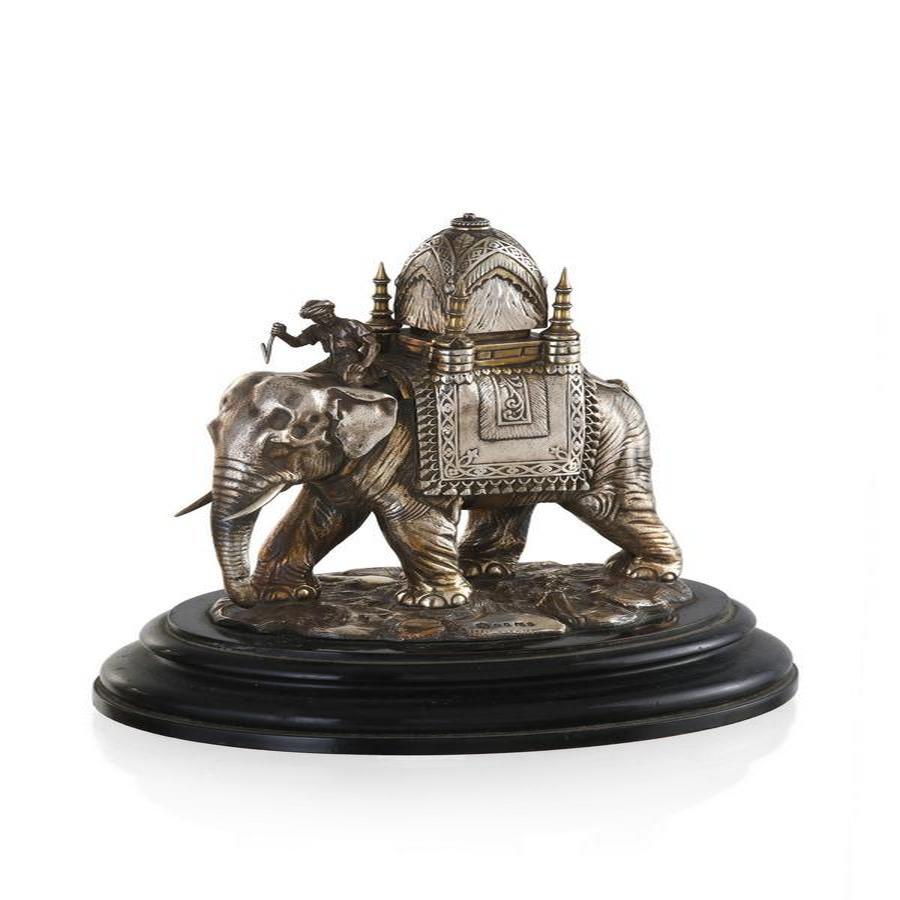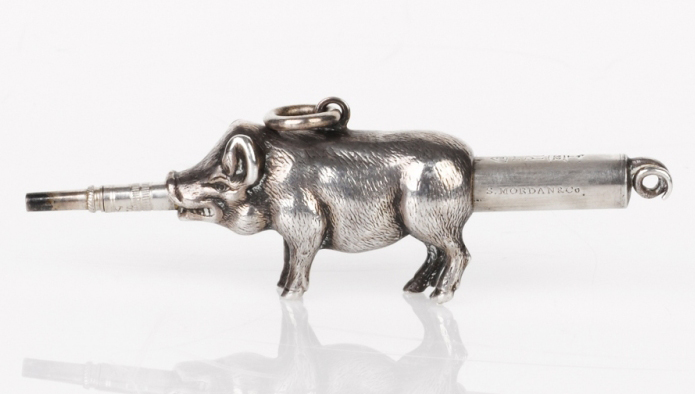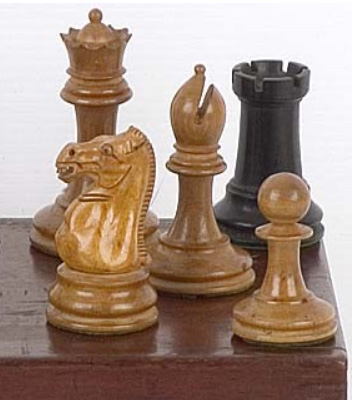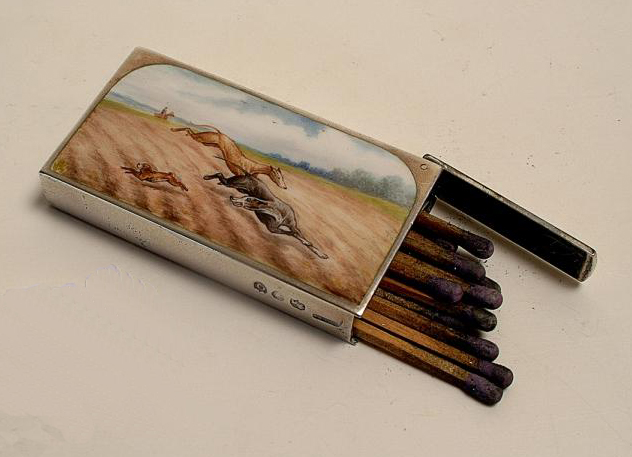Learn about antiques and collectables...
Click on a category below to show all the entries for that category.
Learn about and understand the items, manufacturers, designers and periods as well as the specialist terms used in describing antiques and collectables. Either click one of the letters below to list the items beginning with that letter, or click on a category on the left side of the screen to list the items under that category.
Averys
Averys are pressed brass needle cases made to hold different sized needles.
The first, the ‘Quadruple Golden Casket’, was produced by William Avery of Redditch, Worcestershire, in 1868, whose father was a needle manufacturer, but competitors soon followed and now the term has been extended to all brass needlecases.
Most Averys date from the 1870s when there was a huge explosion in production. The needles are held in rows that move, or in slots that hold packets.
There are three types of Averys – flats, quadruples and figurals. Figurals are the most desirable and valuable, with many shapes inspired by nature.
Cartier
Cartier is a luxury goods manufacturer founded in 1847 by Louis-François Cartier in Paris, France. The company began as a jewelry workshop and soon gained a reputation for producing high-quality, innovative designs. In the late 1800s, Cartier began to expand its product line to include watches and other luxury goods.
In the 1920s and 1930s, Cartier became known for its Art Deco designs and its use of precious materials such as gold and diamonds. The company also began to produce a wide variety of luxury goods, including pens, lighters, and cigarette cases. In 1917, the company was sold to the jeweller Alfred Cartier, Louis-Francois' son, who further developed the brand.
During the 1950s and 1960s, Cartier continued to be a major player in the luxury goods market, and it began to develop its own line of perfumes and accessories.
In 1972, the company was acquired by a consortium led by Joseph Kanoui, who helped to expand the company's presence in Asia and the Middle East.
Today, Cartier is a subsidiary of the Richemont group and it continues to produce a wide range of luxury goods, including watches, jewelry, and leather goods. It is known for its high-quality craftsmanship, distinctive design, and iconic brand.
Chad Valley Toys
Chad Valley is a toy company that was founded in the United Kingdom in the late 19th century. It is known for producing a wide range of toys and games for children, including dolls, action figures, board games, and puzzles. Chad Valley toys are known for their high quality and durability, and they are popular with children and collectors alike. The company was originally founded by Arnold Lowe as a small toy shop in Birmingham, England and it quickly grew in popularity and began producing its own toys, which were sold both in the UK and abroad. In the 1920s, Chad Valley became one of the largest toy manufacturers in the world, and it continued to expand throughout the 20th century. Today, Chad Valley is still a well-known and respected brand in the toy industry.
Cigarette Cases
Pocket cigarette cases evolved from the leather containers for cigars which first became popular in the mid-nineteenth century. As cigarette smoking gradually overtook cigar smoking, pocket cigarette cases in leather or papier mache often decorated with floral motifs or geometric patterns became popular.
After 1900, however, pocket cigarette cases of an all-metal construction came into fashion.
The metal pocket cigarette cases were most frequently made of silver and gold, and plated versions of these metals, and offered greater scope to the designers and craftsmen and soon enamelling, filigree work, guilloche engraving and other decorative techniques could be found decorating cigarette cases.
As well as gold and silver, pocket cigarette cases were made in ivory, wood, Lucite, pewter.
A lerger version of the cigarette case evolved to sit on a desk or sideboard. Many of these were silver boxes, lined with timber. A popular form was the miniature AWA radio table cigarette box, in various colours of Bakelite. Others were made of wood and ceramics.
Cigarette Lighters
Cigarette lighters can be subdivided into three types: pocket lighters, table lighters and compact lighters with cases.
Dunhill is the most popular and desirable name for collectors. Their first lighter was released in the early 1920s and they are still producing today.
Other collectable manufacturers are Ronson, who have been making lighters for over 100 years and invented the automatic lighter in 1926, and Zippo, which was founded in 1932.
Lighter collectors should look for inset watches or concealed features such as compacts.
Early lighters were powered by naphtha, a petroleum mixture, and these are more desirable than the butane gas lighters, that were introduced in the late 1940s.
Lighters made from precious materials, often by jewelers, or those in novelty shapes such as aeroplanes and animals are popular. Wear to plating or loss of parts of covering will affect value detrimentally, as will dents or splits. Replaced parts will also affect value.
Compendium
A compendium is usually a wooden box that has several compartments and drawers for storing the various items. A stationery compendium would be used for storing and organizing various personal or business items including documents, business cards, passports, and other items that need to be organized and easily accessible. It is typically a wooden box t
A compendium for correspondence would usually have pockets for holding different sizes of envelopes, and sometimes may have a built-in address book or a calendar. It can also have a pen loop or holder, and sometimes a calculator.
Conway Stewart
In 1905 Conway Stewart was established in East London to manufacture fountain pens. Around 1919, Conway Stewart began producing lever filling fountain pens in which ink was sucked into the sack by using a metal lever in the barrel. Their designs were aimed mainly at clerical workers and students and were therefore often bright and inventive. Although they produced pens with alternative filling systems, the bulk of sales remained lever fillers.
During the 1920s and ’30s they used the new plastics to create pens in every conceivable colour and in patterns imitating everything from Italian marble to cracked ice. Some of the prettiest were the small pens designed for ladies and known as ‘Dinkies’, many of which came with a ring in the cap so that they could be worn on a ribbon.
The next size up was known as a ‘Dandy’. A vast number of model number/colour/pattern combinations were made making these pens a popular collectable item.
The firm suffered financially in the 1960s, due to the popularity of cartridge pens and the dominance of the Biro, and in 1975 the business was wound up.
In 1998, a new company was registered under the name of Conway Stewart based in Plymouth, Dorset to produce pens for the upper-end of the pen market. The range is characterised by the use of precious metals, enamels, and special edition pens.
Decanters
The earliest decanters date from the late seventeenth century and were made from blown moulded glass.
They were used to serve wine at a time when there was a move towards less formal dining procedures and the reduced reliance on servants and waiters.
The 1745 Excise Tax caused manufacturers to make decanters lighter in weight. The tax benefited the industry in Ireland where it did not apply. When the tax was repealed in 1845, a heavier gauge was reverted to.
In the second half of the eighteenth century blue, green and amethyst coloured decanters were made.
Decanters often sat on silver bottle coasters with baize bases (some even on castors) and could be 'pushed' around the dining table without making scratches or requiring serving staff.
Dunhill, Alfred Ltd.
Alfred Dunhill Ltd was founded in London in 1893 as a motoring accessories business.
In the 1900s, the company expanded into luxury tobacco goods. As cigarette smoking took off in the 1920s and ’30s, Dunhill became one of the most famous names in the field, opening shops in Paris, New York and Toronto and expanding into menswear, toiletries and other areas, but it is with smoking accessories that the firm is most notably associated.
Dunhill was particularly known for lighters, most famously the Unique lighter, launched in the early 1920s with the slogan ‘The lighter that changed public opinion’. Coming in various designs, the Unique could be operated with one hand; its design lessened the risk of petrol evaporation and it rarely needed filling. Dunhill also developed the first butane gas powered lighter.
Dunhill began manufacturing cigarettes in 1963. In 1967, Carreras Tobacco Company acquired a 51% interest in the company, and the company is currently owned by Compagnie Financière Richemont SA, a Swiss based luxury goods manufacturer whose brands include Baume & Mercier (watches) Cartier (jewellery and watches) IWC (watches), Montblanc (pens), Piaget (watches and jewellery)
Alfred Dunhill have retail emporiums for men in the major cities of London, Shanghai and Tokyo, and Hong Kong, referred to as the 'Homes of Alfred Dunhill'. As well being a retail outlet for Dunhill goods, these 'Homes' offer a range of services including a bespoke tailoring service, barber’s shop, fine wine cellars, bar or restaurant, screening room, and spa.
Dunhill's current product range includes men's luxury leather goods, writing implements, lighters, timepieces, fragrances and clothing.
Horn
Full horns were used for making drinking vessels and powder horns. A number of larger horns or antlers could be combined together to make furniture and decorative items such as chairs and lamps.
As a material, horn was formerly used in all types of objects such as snuff boxes, lanterns, musical instruments, items for personal grooming, cutlery handles, walking sticks. Some items of horn are finely decorated with silver or mounted in silver.
Parker 51
The design for the Parker 51 was completed in 1939, Parker's 51st anniversary, hence the name. There were many unique features to the 51 including the tubular hooded nib and an ink collector separate to the feed. Manufactured in a new plastic material 'Lucite', they were revolutionary. The first model was released in the USA in 1941, at a price of $12.50 and until 1948 was sold with a 'Vacumatic' filling system. In 1948 Parker introduced the 'Aerometric Filler'. This series was designated Mk 1 and was manufactured until 1972. Around 1969 a Mk II was introduced with conical ends and a slimmer cap. Later a Mk III was released, similar to the Mk II but now with a metal cap jewel and 'Injection Moulded'. Production continued until around 1980.
Pencils
Graphite was discovered and came into widespread use for writing following the discovery of a large deposit in Borrowdale, England in 1564. It made a darker line than lead, but was soft and brittle, and required a holder.
The graphite sticks were firstly wrapped in string, but later the graphite was inserted into hollowed wooden sticks the resultant pencil being similar to those in use today.
Britain soon lost its monopoly on production of wooden pencils and they were mass-produced in Germany from the 15th century. In the mid 16th century a number of German pencil manucturers were established whose trade names are still in use today, including Faber-Castell, Steadtler and Lyra.
In 1822, Sampson Mordan (1770 - 1843) with his partner, John Hawkins patented a "metal pencil with an internal mechanism for propelling the graphite 'lead' shaft forward during use", now known as the propelling pencil.
This meant that the casing could now be metal, most commonly gold or silver, which had appeal to the increasingly affluent middle and upper classes in Britain in the 19th century.
Various whimsical patterns were introduced for their propelling pencils including pig and boar-shaped pencils, and horse heads, dogs, cats, fish, frogs and owls.
In Britain between 1820 and 1873, more than 160 patents were filed by the company for various mechanical pencil designs. The first spring-loaded mechanical pencil was patented in 1877 and a twist-feed mechanism was developed in 1895.
Some mechanical pencils only hold the graphite in position against gravity, while others are able to feed the lead through the pencil, as it wears down.
There are various mechanisms used to feed the lead through the pencil, including ratchet-based pencils in which the lead is advanced by a button on the end or the side; screw-based pencils in which the lead is advanced by twisting a screw, which moves a slider down the barrel and twist-based pencils in which the lead is advanced by twisting the head of the pencil.
Mechanical pencils are still in demand today by architects, draughtsmen and artists.
Pontil Mark
A pontil mark, also known as a pontil scar, is a distinctive mark or scar found on the base of certain types of glass. It is a remnant of the glassblowing process and is particularly associated with handcrafted items made prior to the widespread use of automated manufacturing.
The pontil mark is created during the final stages of production. After the glassblower has shaped and formed the glass object, it is removed from the blowing iron. At this point, the glass object is often attached to a solid rod called a pontil rod or punty for further shaping, finishing, or attaching additional components. The attachment point is typically at the base of the object.
Once the glass item is complete, it is detached from the pontil rod, leaving behind a mark or scar on the base. This mark can take various forms, such as a rough or irregular surface, a concave or slightly recessed area, or a small circular scar. The presence of a pontil mark indicates that the item was handcrafted rather than mass-produced.
Collectors and historians often use pontil marks as clues to determine the age, authenticity, and production methods of glass or ceramic pieces. Different types of pontil marks may suggest different techniques used in the production process. For example, an open pontil mark is one where the scar is left as an exposed, roughened area, while a closed pontil mark occurs when the scar is smoothed or covered in some way. It's important to note that not all handcrafted glass items have pontil marks, as some artisans developed alternative methods for finishing their work. In Edwardian times the pontil mark was oftern ground off leaving a concave circle in the centre of the base of the object.
The use of pontil marks diminished with the advent of industrialization and automated manufacturing processes in the 19th and 20th centuries.
Pounce Pot
Pounce is a fine powder made from pine resin or cutlefih bone, that was sprinkled over wet ink to hasten the drying process and was in use from the Middle Ages to the end of the 18th century, prior to the invention of blotting paper. The pounce was usually kept in a pounce pot, a small container in wood, silver or ceramics, kept on a desk, similar to a salt shaker.
Seals
A seal is an engraved stamp for making impressions on sealing-wax. The seal was made by heating sealing wax and dropping it onto the paper, and then placing the seal into the soft wax. Seals were originally used to provide authenticity to documents and proclamations, and in the 19th century to seal letters, before the introduction of the gummed flap. Seals were often set into rings, hung on watch fob chains or neck chains, and there was also a more substantial freestanding desk model with a handle. The seal could be made of any material that could be finely engraved with a monogram or other symbol, including agate, black onyx, bloodstone, cornelian, jasper and lapis lazuli. For desk seals, materials used for the handles included gold, pinchbeck, ivory, hardstones, silver, brass, steel, and coloured twist glass. Seals were fell out of use with the introduction of the penny post in 1840, which led to the evolution of the gummed envelope meaning it was no longer necessary to place a seal every envelope.
Sewing Bobbin
Prior to the invention of the sewing machine bobbins comprised a slender spool made from ivory, bone or wood used to hold thread for making bobbin lace.
Standish
Although the word is little used nowadays, a standish is an inkstand on feet and usually in silver or silver plate, containing some of the following: inkwells, a pounce pot, a sealing wax container and a pen rest. Standishes are also found in less common materials including boulle, marble, brass and wood.
Staunton Chess Set
How should the king, queen, rooks and other pieces be depicted? Why is the king always the tallest piece and have a cross on his head. And why is the knight depicted as a horse head?
Until the adaption of a standard design, the designs of the pieces in every set varied. The Staunton chess set set a standard design for each piece used in the game of chess, and was the style adopted for use in chess competitions.
The Staunton designs were developed in 1849 and sold by sports and games manufacturers Jaques & Son of London, and were either designed by the proprietor of the firm, John Jaques or his his brother in law, Nathaniel Cook.
The design was named after Howard Staunton, an English chess player who was regarded as the leading player in the 1840s to 1850s.
The style has been popular for more than 160 years, and is still the standard today in tournament chess games and competitions.
Tobacco Box
Tobacco was introduced into England in the 16th century, but it wasn't until the 1660s that it became available for popular use. Tobacco boxes were made from the seventeenth century in most metals and shapes, the main feature being a close-fitting lid and smooth outlines so that it did not tear the pocket. English tobacco boxes tended to be plain with perhaps a monogram or coat of arms, but Continental boxes were often elaborately adorned with masculine designs of sporting, military or rustic themes. Their use went into some decline when tobacco manufacturers supplied their wares in tins and many smokers preferred a leather tobacco-pouch.
Tobacco Jars
Unlike tobacco boxes, which were portable, tobacco jars were designed to sit on a shelf or in a cupboard and was therefore included more decoration and a greater variety of shapes than the tobacco box. They were mostly made of ceramic, glass or silver although earlier examples are of lead or pewter. Some had an interior weight to keep the tobacco compressed. Early seventeenth-century examples are cylindrical, often with a domed lid with a finial. Eighteenth-century tobacco jars were often in wood, especially lignum vitae, elegantly shaped, frequently with a liner of pottery or tin. Many of the well-known ceramics factories made tobacco jars. They were a popular item for Royal Doulton, and Wedgwood made very attractive examples in black basalt and blue jasper.
Typewriter
Whilst a 1714 patent granted to the Englishman Henry Mill appears to be for a typewriter of sorts, it was not until the 19th century that the modern typewriter began to evolve.
This was arguably Frenchman Xavier Progin's 1833 creation which was originally called 'Machine Kryptographique'.
Several typewriters featured in the 1851 Great Exhibition which was held in London's Hyde Park.
However, real success came later in the 1880's with Remington when they mastered the technical problems of production as well as successfully convincing a previously somewhat indifferent public.
For the next hundred years, the typewriter became an indispensable tool for the office, and occasionally for the home. In first world countries it has been completely superceded by the personal computer, but in less wealthy countries its use continues, although at a declining rate.
The major typewriter manufacturers were Adler, Remington, IBM, Imperial Typewriters, Olivetti, Olympia, Royal Typewriter Company, Smith Corona and Underwood.
Vesta Cases
In Roman mythology, Vesta was the goddess of hearth, home and family, and her presence was symbolised by the sacred fire that burned at her hearth and temples, inspiring several match companies to name their matches "vestas", the best known around 1900 being the "Swan Vestas" brand.
Vesta cases, also known as match safes were made to safely house a person's supply of matches, required because early matches were prone to combustion, either from the friction of rubbing together or spontaneous ignition.
Vesta cases came into use in the 1830s, but the peak period of their popularity was 1890 to 1920.
Most commonly they are silver, and rectangular in shape, with an end-opening spring-loaded close fitting lid at the top and a ribbed or serrated striking surface on the base.
Collectors seek out novelty shapes that include boots and shoes, bottles, snuff horns, animal heads, hearts, and circles.
However they were also made in gold, and enamel with silver, as well as cheaper materials such as brass and from nuts embellished with silver mounts.
One of the prolific makers of silver vesta cases was the firm Sampson Mordan & Co. which was founded in in 1823 and continued in the family until 1941 when the factory was destroyed by German bombing during the London Blitz.
The smoker's need for vesta cases (and matches) was in gradual decline from after World War I, with the introduction of the Ronson "Banjo" cigarette lighter in 1926, the first automatic lighter, followed by the "Zippo" lighter in 1932.




